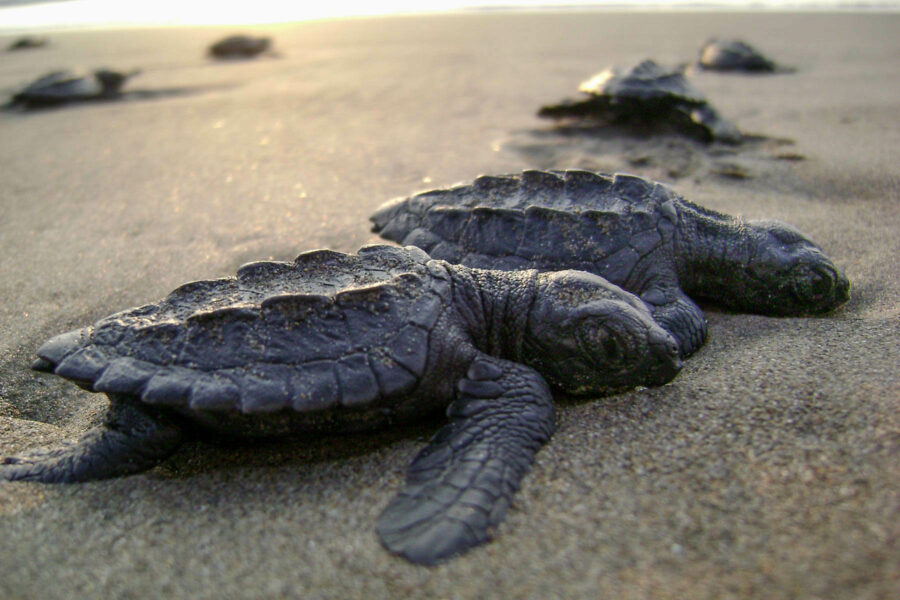A turtle tied to the tides
How climate change holds the fate of the most endangered turtles in the world

Have you ever seen a sea turtle in the Chesapeake Bay? If so, it may have been a juvenile Kemp’s ridley sea turtle. Second only to loggerhead turtles in numbers, Kemp’s ridleys visit the underwater grass beds of the southern Bay from May to November to feed on blue crabs and other crustaceans.
An endangered sea turtle
Despite being the second most common sea turtle in the Bay, Kemp’s ridley sea turtles are in trouble. They are listed as critically endangered under the U.S. Endangered Species Conservation Act—the last recorded population count estimated 4,395 nesting females, far below the 10,000 needed to downlist the species.
Kemp’s ridley sea turtles have struggled for the better part of a century. They faced a monumental decline in the 1940s and 1950s due to intense egg exploitation and incidental capture in recreational and commercial fishing gear. International conservation efforts in the 1960s and 1970s led to enhanced protection of nesting females, nests and hatchlings, as well as the shrimping industry in the Gulf of Mexico implementing devices that allowed sea turtles caught in their nets to escape. These efforts led to a gradual recovery from the mid-1990s through 2009.
Unfortunately, the story doesn’t end there. Kemp’s ridley sea turtle populations started to decline again in 2010 following with the Deep Water Horizon oil spill. More than 600 turtles were found dead during the oil spill response, 75% of which were Kemp’s ridleys.
Effects of climate change
Kemp’s ridley populations have suffered further because of climate change. Sea turtles are particularly vulnerable to increases in temperature, changing currents, extreme weather and sea level rise.
Temperature and changing currents
The sex of baby sea turtles is dependent on the incubation temperature of their eggs. Higher temperatures produce more females, throwing off the necessary sex ratio to produce offspring. Already, the rising temperature of sand might be too high to produce males; for the last two decades, green sea turtles in the Great Barrier Reef have already been producing clutches of up to 99% female hatchlings.
Climate change doesn’t just cause warming; it also affects ocean circulation and currents. The distribution of hatchling and juvenile Kemp’s ridley sea turtles is triggered by ocean currents, which generally disperses the turtles to their native nesting beaches. When climate change alters ocean currents, the dispersal patterns of sea turtles is disrupted. This causes turtles to be caught in areas with lower water temperatures, preventing them from departing.
When sea turtles are exposed to cold temperatures for long stretches, it can cause cold-stunning events. Cold-stunned turtles are often hypothermic and stranded, a condition few survive. A study by the University of Massachusetts at Amherst found that cold-stunning and stranding events among juvenile Kemp's ridley sea turtles are increasing at an “alarming” rate. Researchers have yet to reach consensus on how climate change will further affect sea turtle cold-stunning events but agree that “climate change may present the broadest threat among many to sea turtle conservation.”
Extreme weather and sea level rise
Along with changing temperatures in the ocean and on land, climate change increases the incidence of extreme weather, which intensifies beach erosion. Kemp’s ridley sea turtles are threatened by beach erosion because it leads to the loss of critical nesting habitat. Tidal flooding, which is also increasing in frequency, can destroy nests. Additionally, sea level rise increases the risk of habitat loss.
Erosion and habitat loss are especially threatening to Kemp’s ridley sea turtles because they return to where they were born to reproduce, regardless of the condition of the beach. The high beach temperatures and habitat loss decreases the chance of successful hatchling production.
Helping sea turtles
Kemp’s ridley sea turtles have been on a rollercoaster of recovery and relapse for decades. Much of the conservation efforts to protect these turtles are taking place in their nesting habitat, around the Gulf of Mexico. Here in the Bay, you can help these turtles by protecting underwater grasses, which provide protection and support blue crabs, a key source of food.
Learn more about the Kemp’s ridley sea turtle in our Field Guide.

Comments
Once again I learned a lot from reading your blog post. I particularly like that you gave me suggestions on what people can do to help address the problem.
Carly expertly explains the challenges facing these unique creatures - Kemp’s ridley sea turtles. This is a fascinating subject.
Thank you!
Your comment has been received. Before it can be published, the comment will be reviewed by our team to ensure it adheres with our rules of engagement.
Back to recent stories